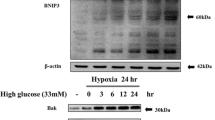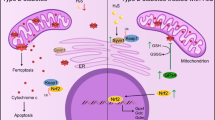Abstract
Diabetic cardiomyopathy (DCM) has become a major cause of diabetes-related morbidity and mortality. Increasing evidences have proved that hydrogen sulfide (H2S) fulfills a positive role in regulating diabetic myocardial injury. The present study was designed to determine whether GYY4137, a novel H2S-releasing molecule, protected H9c2 cells against high glucose (HG)-induced cytotoxicity by activation of the AMPK/mTOR signal pathway. H9c2 cells were incubated in normal glucose (5.5 mM), 22, 33, and 44 mM glucose for 24 h to mimic the hyperglycemia in DCM in vitro. Then we added 50, 100, and 200 μM GYY4137, and measured the cell viability, lactate dehydrogenase (LDH) enzyme activity, and mitochondrial membrane potential (MMP). 0.5 mM 5-amino-4-imidazole-carboxamide riboside (AICAR, an AMPK activator) and 1 mM adenine 9-β-d-arabinofuranoside (Ara-A, an AMPK inhibitor) were used to identity whether the AMPK/mTOR signal pathway was involved in GYY4137-mediated cardioprotection. We demonstrated that HG decreased cell viability and increased LDH enzyme activity in a concentration-dependent manner. 33 mM HG treatment for 24 h was chosen as our model group for further study. Both 100 and 200 μM GYY4137 treatments significantly attenuated HG-induced cell viability decrement, LDH enzyme activity increase, and MMP collapse. AICAR had similar effects to GYY4137 treatment while Ara-A attenuated GYY4137-mediated cardioprotection. Importantly, both GYY4137 and AICAR increased AMPK phosphorylation and decreased mTOR phosphorylation compared with the HG model group while Ara-A attenuated GYY4137-mediated AMPK phosphorylation increase and mTOR phosphorylation decrement. In conclusion, we propose that GYY4137 likely protects against HG-induced cytotoxicity by activation of the AMPK/mTOR signal pathway in H9c2 cells.




Similar content being viewed by others
Abbreviations
- DCM:
-
Diabetic cardiomyopathy
- H2S:
-
Hydrogen sulfide
- HG:
-
High glucose
- LDH:
-
Lactate dehydrogenase
- MMP:
-
Mitochondrial membrane potential
- AICAR:
-
5-Amino-4-imidazole-carboxamide riboside
- Ara-A:
-
Adenine 9-β-d-arabinofuranoside
References
Chen L, Magliano DJ, Zimmet PZ (2012) The worldwide epidemiology of type 2 diabetes mellitus—present and future perspectives. Nat Rev Endocrinol 8(4):228–236
Battiprolu PK, Lopez-Crisosto C, Wang ZV, Nemchenko A, Lavandero S, Hill JA (2013) Diabetic cardiomyopathy and metabolic remodeling of the heart. Life Sci 92(11):609–615
Goyal BR, Mehta AA (2013) Diabetic cardiomyopathy: pathophysiological mechanisms and cardiac dysfunction. Hum Exp Toxicol 32(6):571–590
Falcao-Pires I, Leite-Moreira AF (2012) Diabetic cardiomyopathy: understanding the molecular and cellular basis to progress in diagnosis and treatment. Heart Fail Rev 17(3):325–344
Hwang SL, Jeong YT, Hye YJ, Li X, Lu Y, Son JK, Chang HW (2013) Pinusolide improves high glucose-induced insulin resistance via activation of AMP-activated protein kinase. Biochem Biophys Res Commun 437(3):374–379
Perna AF, Luciano MG, Ingrosso D, Raiola I, Pulzella P, Sepe I, Lanza D, Violetti E, Capasso R, Lombardi C, De Santo NG (2010) Hydrogen sulfide, the third gaseous signaling molecule with cardiovascular properties, is decreased in hemodialysis patients. J Ren Nutr 20(5 Suppl):S11–S14
Blackstone E, Morrison M, Roth MB (2005) H2S induces a suspended animation-like state in mice. Science 308(5721):518
Kashfi K, Olson KR (2013) Biology and therapeutic potential of hydrogen sulfide and hydrogen sulfide-releasing chimeras. Biochem Pharmacol 85(5):689–703
Zhou X, Lu X (2013) Hydrogen sulfide inhibits high-glucose-induced apoptosis in neonatal rat cardiomyocytes. Exp Biol Med (Maywood) 238(4):370–374
Peake BF, Nicholson CK, Lambert JP, Hood RL, Amin H, Amin S, Calvert JW (2013) Hydrogen sulfide preconditions the db/db diabetic mouse heart against ischemia-reperfusion injury by activating Nrf2 signaling in an Erk-dependent manner. Am J Physiol Heart Circ Physiol 304(9):H1215–H1224
Li L, Whiteman M, Guan YY, Neo KL, Cheng Y, Lee SW, Zhao Y, Baskar R, Tan CH, Moore PK (2008) Characterization of a novel, water-soluble hydrogen sulfide-releasing molecule (GYY4137): new insights into the biology of hydrogen sulfide. Circulation 117(18):2351–2360
Hardie DG (2007) AMP-activated/SNF1 protein kinases: conserved guardians of cellular energy. Nat Rev Mol Cell Biol 8(10):774–785
Ruderman NB, Xu XJ, Nelson L, Cacicedo JM, Saha AK, Lan F, Ido Y (2010) AMPK and SIRT1: a long-standing partnership? Am J Physiol Endocrinol Metab 298(4):E751–E760
Purushotham A, Schug TT, Xu Q, Surapureddi S, Guo X, Li X (2009) Hepatocyte-specific deletion of SIRT1 alters fatty acid metabolism and results in hepatic steatosis and inflammation. Cell Metab 9(4):327–338
Mantovani J, Roy R (2011) Re-evaluating the general(ized) roles of AMPK in cellular metabolism. FEBS Lett 585(7):967–972
Liao LZ, Chen YL, Lu LH, Zhao YH, Guo HL, Wu WK (2013) Polysaccharide from Fuzi likely protects against starvation-induced cytotoxicity in H9c2 cells by increasing autophagy through activation of the AMPK/mTOR pathway. Am J Chin Med 41(2):353–367
Bian S, Sun X, Bai A, Zhang C, Li L, Enjyoji K, Junger WG, Robson SC, Wu Y (2013) P2X7 integrates PI3K/AKT and AMPK-PRAS40-mTOR signaling pathways to mediate tumor cell death. PLoS One 8(4):e60184
Dyck JR, Lopaschuk GD (2006) AMPK alterations in cardiac physiology and pathology: enemy or ally? J Physiol 574(Pt 1):95–112
Chen BL, Ma YD, Meng RS, Xiong ZJ, Wang HN, Zeng JY, Liu C, Dong YG (2010) Activation of AMPK inhibits cardiomyocyte hypertrophy by modulating of the FOXO1/MuRF1 signaling pathway in vitro. Acta Pharmacol Sin 31(7):798–804
Matsui Y, Takagi H, Qu X, Abdellatif M, Sakoda H, Asano T, Levine B, Sadoshima J (2007) Distinct roles of autophagy in the heart during ischemia and reperfusion: roles of AMP-activated protein kinase and Beclin 1 in mediating autophagy. Circ Res 100(6):914–922
Jain SK, Manna P, Micinski D, Lieblong BJ, Kahlon G, Morehead L, Hoeldtke R, Bass PR, Levine SN (2013) In African American type 2 diabetic patients, is vitamin D deficiency associated with lower blood levels of hydrogen sulfide and cyclic adenosine monophosphate, and elevated oxidative stress? Antioxid Redox Signal 18(10):1154–1158
Brancaleone V, Roviezzo F, Vellecco V, De Gruttola L, Bucci M, Cirino G (2008) Biosynthesis of H2S is impaired in non-obese diabetic (NOD) mice. Br J Pharmacol 155(5):673–680
Zhong X, Wang L, Wang Y, Dong S, Leng X, Jia J, Zhao Y, Li H, Zhang X, Xu C, Yang G, Wu L, Wang R, Lu F, Zhang W (2012) Exogenous hydrogen sulfide attenuates diabetic myocardial injury through cardiac mitochondrial protection. Mol Cell Biochem 371(1–2):187–198
Xue R, Hao DD, Sun JP, Li WW, Zhao MM, Li XH, Chen Y, Zhu JH, Ding YJ, Liu J, Zhu YC (2013) Hydrogen sulfide treatment promotes glucose uptake by increasing insulin receptor sensitivity and ameliorates kidney lesions in type 2 diabetes. Antioxid Redox Signal 19(1):5–23
Zhang X, Chen C (2012) A new insight of mechanisms, diagnosis and treatment of diabetic cardiomyopathy. Endocrine 41(3):398–409
Boudina S, Abel ED (2007) Diabetic cardiomyopathy revisited. Circulation 115(25):3213–3223
Aurigemma GP, de Simone G, Fitzgibbons TP (2013) Cardiac remodeling in obesity. Circ Cardiovasc Imaging 6(1):142–152
Bugger H, Abel ED (2008) Molecular mechanisms for myocardial mitochondrial dysfunction in the metabolic syndrome. Clin Sci (Lond) 114(3):195–210
Akbal E, Ozbek M, Gunes F, Akyurek O, Ureten K, Delibasi T (2009) Serum heart type fatty acid binding protein levels in metabolic syndrome. Endocrine 36(3):433–437
Buchanan J, Mazumder PK, Hu P, Chakrabarti G, Roberts MW, Yun UJ, Cooksey RC, Litwin SE, Abel ED (2005) Reduced cardiac efficiency and altered substrate metabolism precedes the onset of hyperglycemia and contractile dysfunction in two mouse models of insulin resistance and obesity. Endocrinology 146(12):5341–5349
Peterson LR, Herrero P, Schechtman KB, Racette SB, Waggoner AD, Kisrieva-Ware Z, Dence C, Klein S, Marsala J, Meyer T, Gropler RJ (2004) Effect of obesity and insulin resistance on myocardial substrate metabolism and efficiency in young women. Circulation 109(18):2191–2196
Kahn BB, Alquier T, Carling D, Hardie DG (2005) AMP-activated protein kinase: ancient energy gauge provides clues to modern understanding of metabolism. Cell Metab 1(1):15–25
Kim MY, Lim JH, Youn HH, Hong YA, Yang KS, Park HS, Chung S, Ko SH, Shin SJ, Choi BS, Kim HW, Kim YS, Lee JH, Chang YS, Park CW (2013) Resveratrol prevents renal lipotoxicity and inhibits mesangial cell glucotoxicity in a manner dependent on the AMPK-SIRT1-PGC1alpha axis in db/db mice. Diabetologia 56(1):204–217
Zou MH, Xie Z (2013) Regulation of interplay between autophagy and apoptosis in the diabetic heart: new role of AMPK. Autophagy 9(4):624–625
Lee HJ, Mariappan MM, Feliers D, Cavaglieri RC, Sataranatarajan K, Abboud HE, Choudhury GG, Kasinath BS (2012) Hydrogen sulfide inhibits high glucose-induced matrix protein synthesis by activating AMP-activated protein kinase in renal epithelial cells. J Biol Chem 287(7):4451–4461
Acknowledgments
This study was supported by National Nature Science Foundation of China (Grant No. 81270296) and Science and Technology Planning Project of Guangdong Province in China (2010B080701105).
Author information
Authors and Affiliations
Corresponding authors
Additional information
Wen-bin Wei and Xun Hu have contributed equally to this work.
Rights and permissions
About this article
Cite this article
Wei, Wb., Hu, X., Zhuang, Xd. et al. GYY4137, a novel hydrogen sulfide-releasing molecule, likely protects against high glucose-induced cytotoxicity by activation of the AMPK/mTOR signal pathway in H9c2 cells. Mol Cell Biochem 389, 249–256 (2014). https://doi.org/10.1007/s11010-013-1946-6
Received:
Accepted:
Published:
Issue Date:
DOI: https://doi.org/10.1007/s11010-013-1946-6




